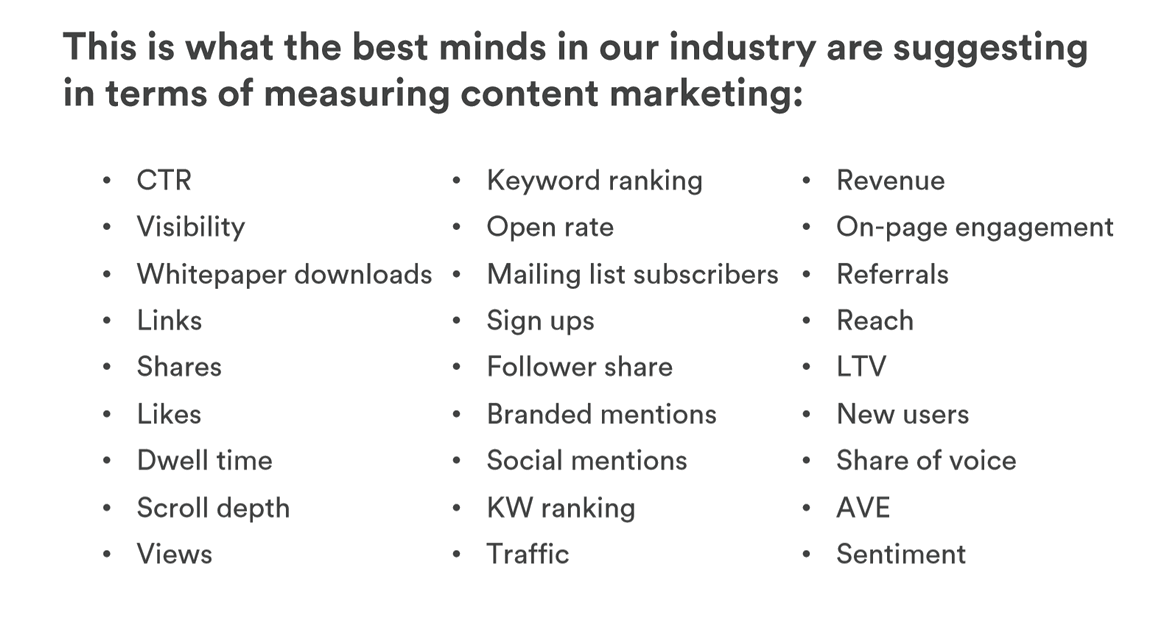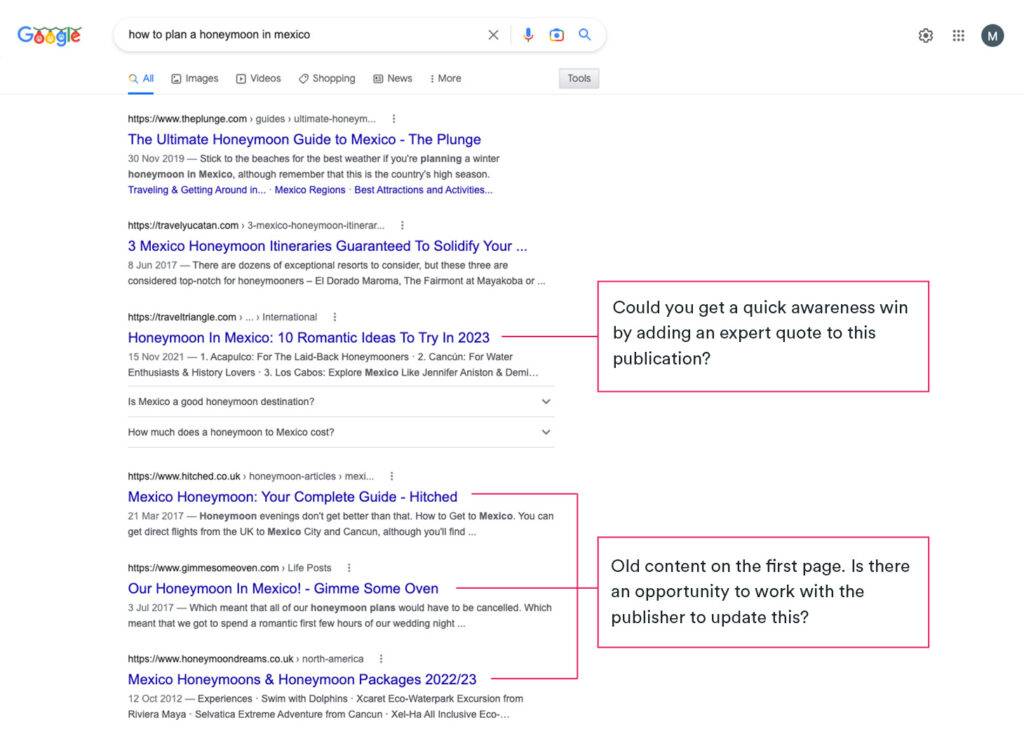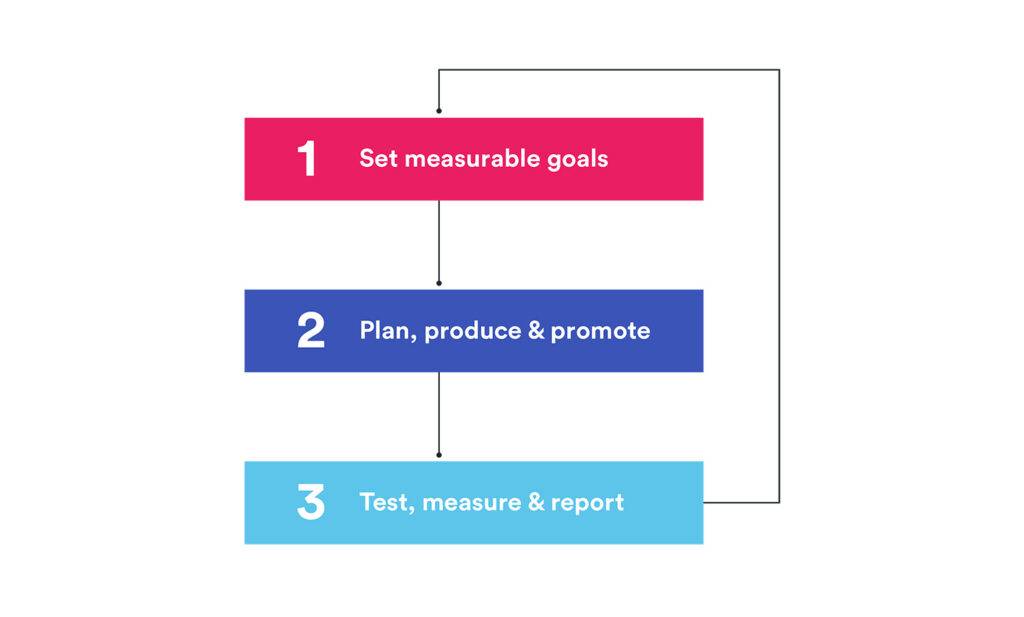You’re not measuring the impact of your content
Knowing how to measure content marketing is the first obstacle in effective budgeting and resourcing. The widely-adopted industry approach often follows this playbook:
1) choose a format
2) pick your channel, and
3) decide how you want to measure your content.
However, there is no general consensus on what good content marketing measurement looks like. Often, marketers are so desperate for content to work that they map metrics to content – not the other way around.
As a result, there are an incredibly broad mix of suggestions on how to measure content marketing. We frequently see metrics used for SEO, PR, and social media attributed to individual pieces of content, and they can often be rather tenuous.

While they can help to monitor general performance, none of these metrics are specific or original. Instead, content marketing measurement needs to factor in a combination of both quantitative and qualitative metrics.
Quantitative metrics include questions such as:
- How much traffic would this content send me?
- How will traffic convert?
- What is a feasible ranking for my site?
- How many links will my content need?
- What are the onsite changes required for me to rank?
Qualitative measurement show content’s value by means of ‘soft’ metrics:
- Is this content helpful to the target audience?
- Does it correspond to a stage in the marketing funnel and/or customer journey?
- Is the topic evergreen?
- What keywords can the content rank for, and are they relevant?
Often, marketers neglect qualitative metrics in their measurement strategy, but these deliverables are equally important in determining the value of content to the target audience.
There is a place for content
As these metrics show, knowing how to drive website traffic with content takes much more than keyword and topic research. Using quantitative and qualitative measurement tactics can help you find specific, realistic and profitable opportunities that demonstrate the value of content marketing.
Budget should only be allocated for its creation when your forecasting, research, and strategy prove there is a need. This should tie your content directly to the performance metrics of the channel it sits within as well as the qualitative metrics that show the value to the audience. Ultimately, if content doesn’t impact these metrics then it shouldn’t exist at all.
How to make the most of your content budget
Below, we’ll explore how you can put these tactics into practice to get the most value from your content without sacrificing your budget.
Focus on quality over quantity
A common misconception is that you need to be creating a lot of content, constantly, in order to rank well. However, a handful of highly-targeted, evergreen, and purposeful articles are better than twenty ‘fluff’ pieces.
A golden rule is to always ensure that content delivers real value to the audience at a particular stage of the customer journey. It should also aim to add value to your brand as a whole, and the wider industry it sits in. If the SERPs look particularly crowded for a topic, focus on adding something new to the conversation instead of contributing to the noise.
Many organisations focus so much on consistent content output that they neglect the content they already have. By repurposing or updating old content, you can be smarter about your own resources and your budget can be put towards other content channels. Refreshing outdated content is a relatively low effort, yet high reward process in comparison to creating it from scratch. Of course, your brand’s content output may not be established enough for this step, or there may be a lack of repurposable content.
A content audit helps you to determine the quality of your current content and gaps in opportunity. To do this, you need to set benchmarks for content performance using the quantitative and qualitative metrics listed above. Then, you can identify content to repurpose and keep, as well as removing anything that doesn’t meet these criteria.
At Builtvisible, we’ve supported countless clients with their content audit and strategy processes. If your in-house team needs a helping hand, feel free to get in touch to see how our content strategy team can support you.
Identify off-page opportunities
As well as reviewing and optimising existing content, you can also capitalise on off-page opportunities. You can do this in two key ways:
- Help to update old content: When you search for a topic that’s relevant to your brand or product, you may notice that all content on the SERPs is outdated or irrelevant. Instead of creating a new piece, you could reach out to the publisher to update the content in a collaboration with the brand or author.
- Hack ranking coverage by providing relevant resources: If you spot the opportunity to offer unique expertise that’s missing in already-ranking content, then you can score a quick awareness win with your contribution.
Let’s imagine that we’re in the shoes of luxury travel brand, Scott Dunn. We could analyse the SERPs for a query such as ‘how to plan a honeymoon in mexico’ to mine for off-page opportunities:

Sometimes it won’t be relevant for your brand to rank, but knowing when to stop can help focus your efforts elsewhere on focused, purposeful content that satisfies user intent.
Create a measurement plan
As we explored above, the right measurement and reporting tactics are everything when it comes to calculating ROI. Deciding what to measure ideally shouldn’t occur after the content is created, but should ideally be factored into the initial planning.

with the relevant quantitative and qualitative metrics.
This must be based on the following:
- Commercial objectives of the business
- Target audience for your content
- User intent that your content will fulfil
User intent tends to change across content at different stages of the funnel, so content performance requires different metrics.
For example, if you’re creating awareness-stage content, then you’ll be looking at metrics like organic rankings, unique pageviews, and quality backlinks. However, content at the conversion stage demands very different reporting metrics. as you’ll be looking for those all-important transactions, sign-ups, and general CTAs.
Establish a tone of voice
For content to have any real impact, it needs to resonate with your target audience. One of the best ways to do this is by establishing a unique, consistent tone of voice.
With what seems like an endless sea of copycat content on the SERPs, brand tone of voice helps you stand out and connect with your audience on a deeper level. It’s even more important to have these guidelines in place when you outsource copywriters or partner with a number of different agencies.
A uniform tone can often make all the difference between bouncing and converting, and you’ll be able to see the value in all areas of your website, not just your content output. Simply put, investing in this lets you reap the rewards for years to come.
At Builtvisible, our copywriting team have supported brands with improving and developing their tone of voice guidelines. Find out more about our strategic copywriting services to see how we can support you.
Get tactical with distribution
Distribution is the cherry on the cake when it comes to maximising the value of your content. If there’s the opportunity for Digital PR efforts such as link building or distributing content on owned channels like social media and email marketing, then you should take it.
When you’ve ticked the box of producing useful, SEO-optimised content, you should also consider how you can enhance that resource to make it more engaging and outreachable. As Head of Digital PR Olivia Wiltshire explains in her recent blog post, an increase in citations and inbound links lead to an increase in traffic and visibility, while boosting the performance of both the page and wider website.
By factoring in Digital PR strategies early on in the process, you’ll strengthen your overall content strategy – improving both the quality of your content and ROI.
Final Notes
Knowing how to get the most out of your content when times are tough is something marketers will need to navigate in our current economic climate. However, hopefully this article has shown that there are many ways to approach content marketing that will let your budget stretch further than you may have planned.
Remember that if content isn’t aligning with your overall goals and doesn’t hit channel-specific KPIs, then it shouldn’t exist at all. To reap the rewards from your content marketing strategy, you should first define the size of the opportunity, the user intent, align content with the most relevant tactic then allocate content spend within the appropriate channel.
Need support on auditing your content or developing a comprehensive content strategy? If you want to find out more about the process and see how Builtvisible can help you, please don’t hesitate to get in touch with our content strategy team.
